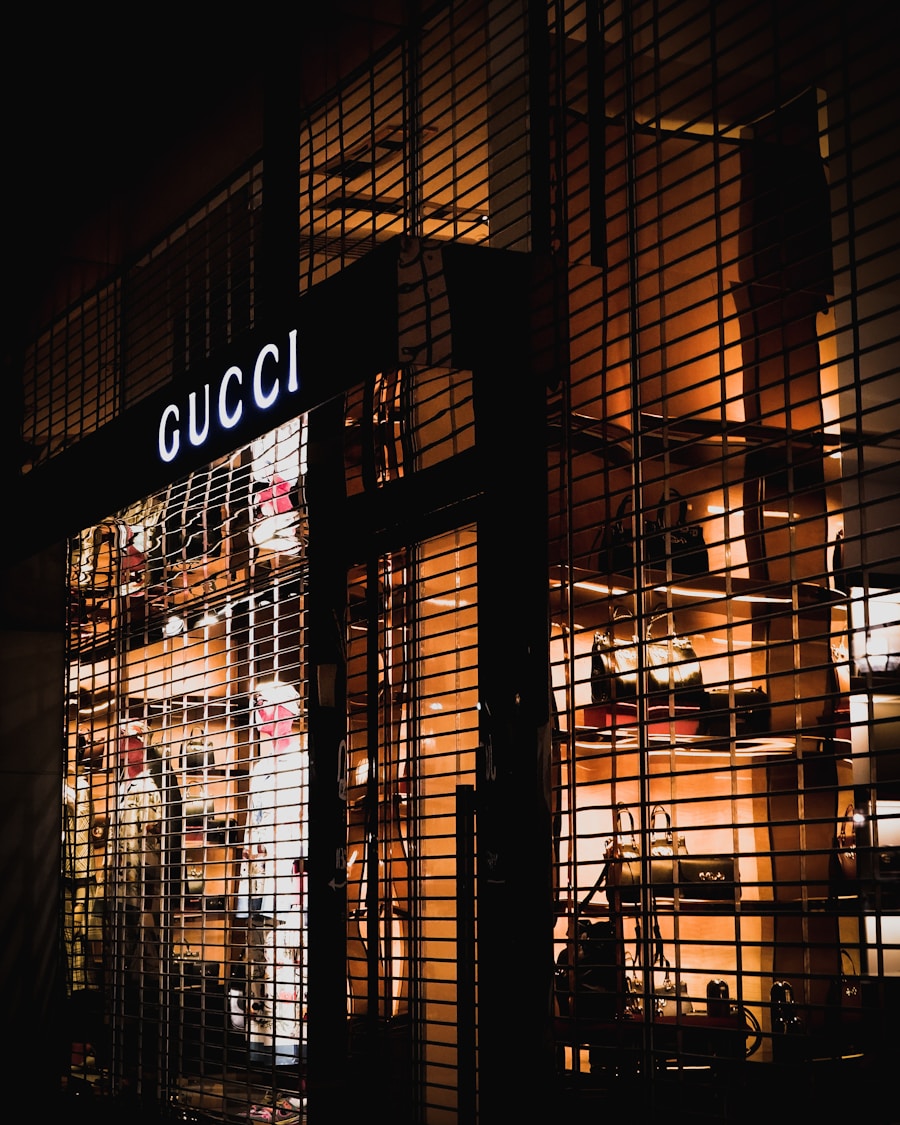The House of Gucci was established in 1921 by Guccio Gucci in Florence, Italy. Initially, Guccio opened a small leather goods and luggage store, drawing inspiration from his experiences working at luxury hotels in London. His vision was to create high-quality leather products that would appeal to the affluent clientele of the time.
The craftsmanship and attention to detail that Guccio infused into his creations quickly garnered a reputation for excellence, setting the foundation for what would become one of the most iconic fashion houses in the world. As the business began to flourish, Guccio’s sons—Aldo, Vasco, and Rodolfo—joined the family enterprise, each contributing their unique talents and perspectives. The brand’s signature elements, such as the green-red-green stripe and the interlocking G logo, were developed during this period, further solidifying Gucci’s identity in the luxury market.
The combination of innovative design and traditional craftsmanship allowed the House of Gucci to stand out among its competitors, laying the groundwork for future expansion and success.
Key Takeaways
- Gucci was founded in 1921 by Guccio Gucci, initially as a small leather goods and luggage company in Florence, Italy.
- Under the leadership of Aldo Gucci, Gucci expanded internationally and became a symbol of luxury and success in the fashion world.
- Family feuds and power struggles within the Gucci family led to a decline in the company’s success and reputation.
- Gucci experienced a resurgence in the 1990s under the creative direction of Tom Ford, leading to a new era of success and innovation.
- Gucci has faced scandals and controversies, including legal battles and accusations of racism, which have impacted the brand’s image and reputation.
The Expansion and Success of Gucci
Establishing a Luxury Presence
By the 1950s, Gucci had established flagship stores in major cities such as New York and Tokyo, solidifying its status as a luxury brand on an international scale.
Hollywood Glamour and Innovation
The allure of Gucci products was further amplified by their association with Hollywood stars like Audrey Hepburn and Grace Kelly, who were often seen sporting the brand’s iconic designs. The 1970s marked a pivotal moment for Gucci as it embraced a more modern aesthetic while maintaining its commitment to quality. The introduction of new lines, such as the famous “Gucci Flora” scarf designed for Princess Grace of Monaco, showcased the brand’s ability to innovate while staying true to its heritage.
A Legacy of Excellence
This era of expansion not only solidified Gucci’s reputation but also set the stage for its future endeavors in the fashion industry.
The Family Feuds and Power Struggles

Despite its success, the House of Gucci was not immune to internal strife. As the family business grew, so did tensions among its members. The rivalry between Aldo and Rodolfo escalated, leading to a power struggle that threatened to fracture the brand.
Aldo’s aggressive expansion strategies clashed with Rodolfo’s more conservative approach, creating a rift that would have lasting implications for the company. This discord was further complicated by the involvement of the next generation, particularly Maurizio Gucci, who sought to assert his influence over the family legacy. The culmination of these family feuds came in the 1980s when Maurizio took control of the company after a series of legal battles with his relatives.
His leadership style was marked by a desire to modernize the brand, but it also led to further divisions within the family. The internal conflicts reached a tragic climax in 1995 when Maurizio was murdered outside his office in Milan, a shocking event that sent shockwaves through both the fashion world and the Gucci family. This tragedy not only highlighted the destructive nature of familial rivalries but also marked a turning point for the brand as it grappled with its identity in the wake of such turmoil.
The Decline and Resurgence of Gucci
| Year | Revenue (in million USD) | Net Income (in million USD) |
|---|---|---|
| 2015 | 4,700 | 1,300 |
| 2016 | 4,490 | 1,180 |
| 2017 | 6,210 | 1,480 |
| 2018 | 8,290 | 2,100 |
| 2019 | 9,630 | 3,200 |
Following Maurizio’s death, Gucci faced a period of decline characterized by financial instability and a loss of direction. The brand struggled to maintain its relevance in an increasingly competitive fashion landscape. In an effort to regain its footing, Gucci underwent several leadership changes and strategic shifts throughout the late 1990s.
The appointment of Tom Ford as creative director in 1994 marked a turning point for the brand. Ford’s bold vision and provocative designs revitalized Gucci’s image, attracting a new generation of consumers while reestablishing its status as a luxury powerhouse. Under Ford’s direction, Gucci experienced a remarkable resurgence in popularity.
The brand embraced a more daring aesthetic that resonated with contemporary fashion trends, leading to record sales and increased visibility on runways and red carpets alike. Ford’s ability to blend sensuality with sophistication reinvigorated the brand’s identity, allowing it to reclaim its position at the forefront of high fashion. This resurgence not only restored Gucci’s financial health but also set a precedent for future creative leadership within the company.
The Scandals and Controversies
Despite its success, Gucci has not been without its share of scandals and controversies. The brand has faced criticism over issues such as cultural appropriation and ethical practices within its supply chain. In recent years, several collections have sparked outrage for their perceived insensitivity towards various cultures and communities.
These controversies have prompted discussions about accountability within the fashion industry and raised questions about how luxury brands navigate cultural representation. Additionally, Gucci has grappled with internal controversies related to its leadership and creative direction. The departure of key figures like Tom Ford and later Alessandro Michele has led to speculation about the brand’s future trajectory.
Each transition has brought about changes in design philosophy and marketing strategies, leaving some loyal customers uncertain about what to expect from Gucci moving forward. These challenges have underscored the complexities of maintaining a legacy brand while adapting to an ever-evolving cultural landscape.
The Reinvention and Modernization of Gucci

In recent years, Gucci has embraced a bold reinvention under the creative direction of Alessandro Michele, who took over in 2015. Michele’s vision has been characterized by an eclectic mix of vintage aesthetics, gender fluidity, and maximalist designs that challenge traditional notions of luxury fashion. His approach has resonated with younger consumers seeking authenticity and individuality in their style choices.
By embracing diversity and inclusivity, Michele has positioned Gucci as a forward-thinking brand that reflects contemporary values. The modernization efforts have extended beyond design; Gucci has also made strides in sustainability and ethical practices. The brand has committed to reducing its environmental impact through initiatives such as using eco-friendly materials and promoting transparency within its supply chain.
This shift towards sustainability aligns with growing consumer demand for responsible fashion choices and demonstrates Gucci’s willingness to adapt to changing societal expectations.
The Legacy and Influence of Gucci
The legacy of Gucci is deeply intertwined with its ability to influence fashion trends and shape cultural narratives over the decades. From its humble beginnings as a leather goods store to becoming a global symbol of luxury, Gucci has consistently pushed boundaries while remaining rooted in its Italian heritage. The brand’s iconic designs have left an indelible mark on fashion history, inspiring countless designers and brands around the world.
Moreover, Gucci’s impact extends beyond clothing; it has become synonymous with a lifestyle that embodies sophistication and glamour. The brand’s collaborations with artists, musicians, and filmmakers have further solidified its cultural relevance, allowing it to transcend traditional fashion boundaries. As a result, Gucci continues to be celebrated not only for its products but also for its contributions to art and culture at large.
The Future of the House of Gucci
Looking ahead, the future of the House of Gucci appears promising yet challenging. As it navigates an ever-changing fashion landscape marked by shifting consumer preferences and technological advancements, maintaining relevance will require innovation and adaptability. The brand must continue to balance its rich heritage with contemporary demands while addressing pressing issues such as sustainability and inclusivity.
Furthermore, as new creative leaders emerge within the company, there will be opportunities for fresh perspectives that can propel Gucci into new realms of creativity and expression. By embracing change while honoring its legacy, Gucci can continue to thrive as a beacon of luxury fashion for generations to come. Ultimately, the House of Gucci stands at a crossroads where tradition meets modernity—a place where it can redefine itself while remaining true to its storied past.
For further reading on this topic, one can explore articles detailing the evolution of luxury brands like Gucci in relation to family dynamics and market trends [here](https://www.businessoffashion.com/articles/news-analysis/the-rise-and-fall-of-gucci-a-family-business-in-crisis/).
If you’re interested in the fashion industry like the one depicted in House of Gucci, you may also enjoy reading about the innovation of stretch fiber technology in today’s apparel industry. This article explores how advancements in fabric technology are revolutionizing the way clothing is made and worn. Check it out here for more information.
FAQs
What is the House of Gucci?
The House of Gucci is an Italian luxury fashion and leather goods brand founded by Guccio Gucci in 1921. It is known for its high-end fashion and accessories, including handbags, shoes, and clothing.
What is the significance of the House of Gucci?
The House of Gucci is renowned for its influence on the fashion industry and its iconic designs. It has become a symbol of luxury and sophistication, attracting a global clientele.
What is the history of the House of Gucci?
The House of Gucci was founded in Florence, Italy, and has grown into a global fashion empire. It has faced various challenges and changes over the years, including family disputes and business restructuring.
What are some popular products from the House of Gucci?
Some popular products from the House of Gucci include the GG Marmont handbag, the Ace sneaker, the Dionysus bag, and the iconic Gucci belts and accessories.
Who are some notable figures associated with the House of Gucci?
The House of Gucci has been associated with influential figures in the fashion industry, including designers such as Tom Ford and Alessandro Michele, as well as celebrity ambassadors and brand collaborators.





